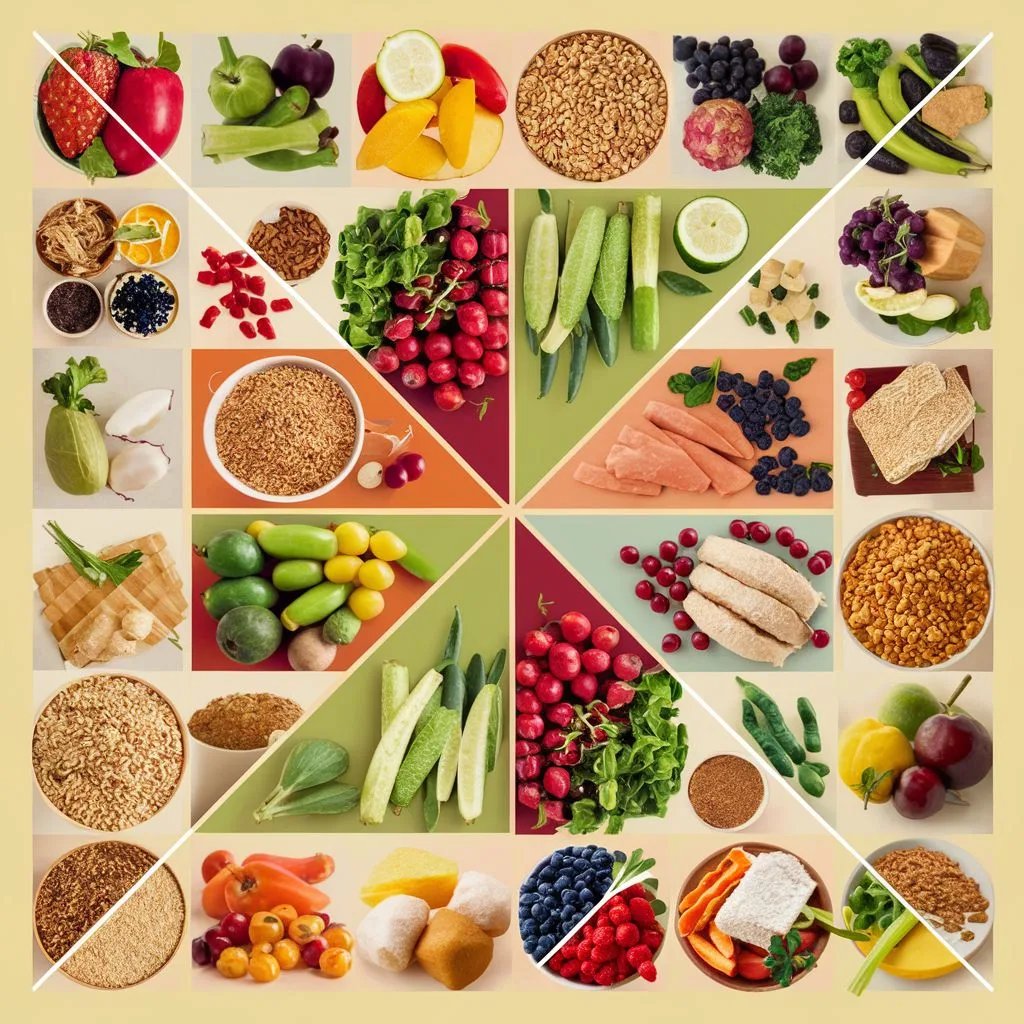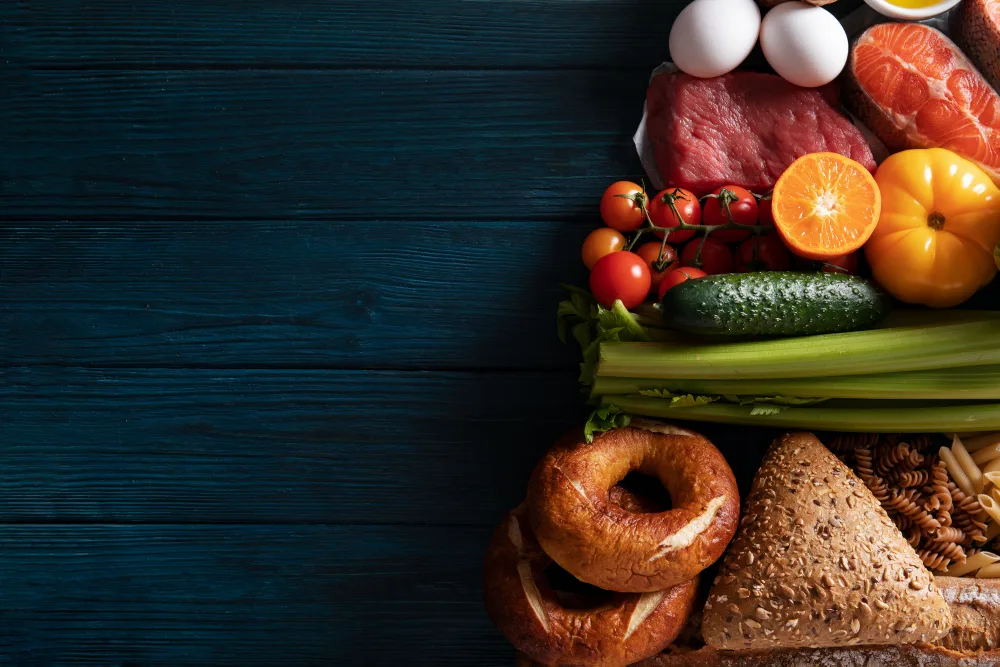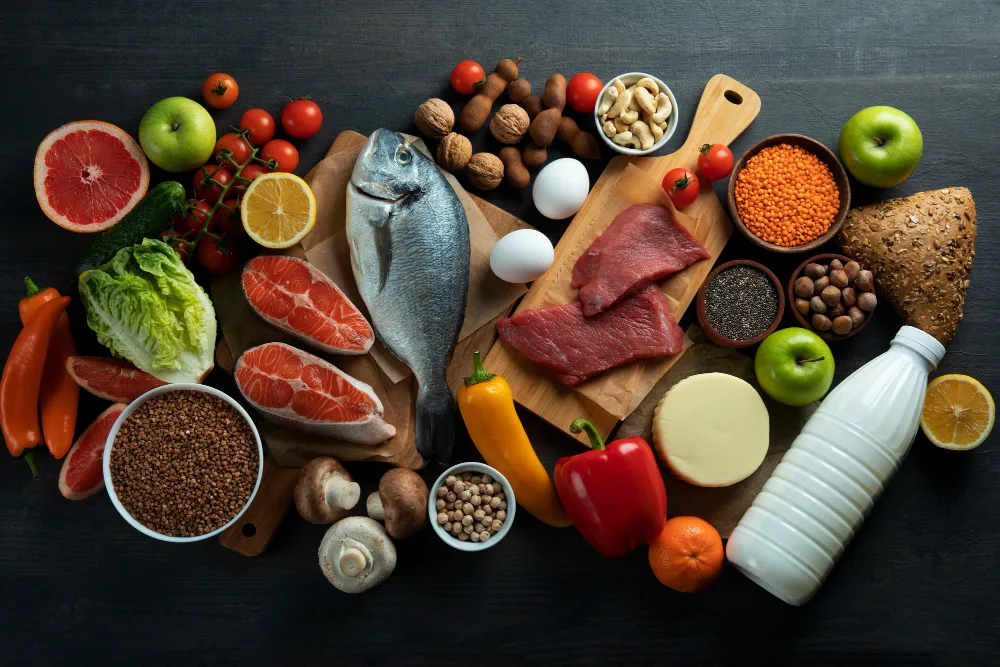Eating smart is the foundation of a healthy lifestyle. It is the roadmap to nutritional wisdom and vibrant living. Smart eating is not just about counting calories or following fad diets. It is about building a balanced diet that provides all the essential nutrients, vitamins, and minerals that our body needs to function optimally.

The principles of nutritional wisdom are simple: eat a variety of whole foods, limit processed foods, and stay hydrated. Building a balanced diet requires us to include a variety of fruits, vegetables, whole grains, lean proteins, and healthy fats. Strategies for healthy eating include mindful eating, portion control, and cooking at home. By following these principles, we can optimize our digestive health, boost our metabolism, and improve our overall health and well-being.
Key Takeaways
- Eating smart is the foundation of a healthy lifestyle and is the roadmap to nutritional wisdom and vibrant living.
- Building a balanced diet requires us to include a variety of whole foods, limit processed foods, and stay hydrated.
- Strategies for healthy eating include mindful eating, portion control, and cooking at home.
Principles of Nutritional Wisdom

Eating smart is not about dieting or depriving ourselves of the foods we love. Rather, it is about making informed choices that nourish our bodies and promote overall health. To achieve nutritional wisdom, we must understand the principles of nutrient density and the role of whole foods in our diet.
Understanding Nutrient Density
Nutrient density refers to the amount of nutrients, such as vitamins, minerals, and antioxidants, in a given amount of food. Nutrient-rich foods, such as leafy greens, berries, and nuts, are packed with essential vitamins and minerals that our bodies need to function optimally. By choosing nutrient-dense foods, we can fuel our bodies with the nutrients they need to thrive.
The Role of Whole Foods
Whole foods are foods that are minimally processed and contain no added sugars or artificial ingredients. Examples of whole foods include fruits, vegetables, whole grains, and lean proteins. By incorporating whole foods into our diet, we can ensure that we are getting the nutrients we need without the added sugars, sodium, and unhealthy fats found in processed foods.
A balanced diet that includes a variety of nutrient-rich, whole foods is key to achieving optimal health and wellness. By making informed choices and prioritizing nutrient density and whole foods, we can pave the way to nutritional wisdom and vibrant living.
Building a Balanced Diet

Eating smart starts with building a balanced diet that is rich in macronutrients and micronutrients. Macronutrients are the nutrients that we need in large amounts, such as carbohydrates, proteins, and fats. They provide us with energy and help our bodies function properly. Micronutrients, on the other hand, are the nutrients that we need in smaller amounts, such as vitamins and minerals. They are essential for maintaining good health, but they do not provide energy.
Macronutrients and Micronutrients
To build a balanced diet, we need to make sure we are getting enough of each macronutrient and micronutrient. Carbohydrates are an important source of energy, and they can be found in foods such as fruits, vegetables, and grains. Proteins are essential for building and repairing tissues, and they can be found in foods such as meat, fish, and beans. Fats are important for energy storage and insulation, and they can be found in foods such as nuts, seeds, and oils.
Micronutrients are just as important as macronutrients, and we need to make sure we are getting enough of them. Vitamins and minerals are essential for maintaining good health, and they can be found in a variety of foods. For example, vitamin C can be found in citrus fruits, while calcium can be found in dairy products.
Incorporating Superfoods
In addition to macronutrients and micronutrients, we can also incorporate superfoods into our diet. Superfoods are foods that are particularly nutrient-dense, meaning they contain a high concentration of vitamins, minerals, and other beneficial nutrients. Some examples of superfoods include blueberries, kale, and salmon.
Incorporating superfoods into our diet can help us get the nutrients we need to maintain good health. For example, blueberries are rich in antioxidants, which can help protect our cells from damage. Kale is a good source of vitamin K, which is important for bone health. And salmon is rich in omega-3 fatty acids, which can help reduce inflammation and improve heart health.
By building a balanced diet that is rich in macronutrients, micronutrients, and superfoods, we can achieve nutritional wisdom and vibrant living.
Strategies for Healthy Eating

Eating healthy is not about following a strict diet, it’s about making smart choices that work for you. Here are some strategies for healthy eating that can help you achieve nutritional wisdom and vibrant living.
Meal Planning Techniques
Meal planning is an effective way to ensure that you have healthy meals available throughout the week. Here are some meal planning techniques that can help you stay on track:
- Plan your meals ahead of time: Take some time to plan out your meals for the week. This can help you stay organized and avoid making unhealthy choices when you’re short on time.
- Make a grocery list: Once you’ve planned your meals, make a list of the ingredients you’ll need. Stick to your list when you’re at the grocery store to avoid buying unhealthy foods.
- Cook in bulk: Consider making large batches of healthy meals that you can eat throughout the week. This can save you time and money in the long run.
Understanding Portion Control
Portion control is an important part of healthy eating. Here are some tips to help you understand portion control:
- Use smaller plates: Using smaller plates can help you eat smaller portions without feeling deprived.
- Measure your food: Use measuring cups and spoons to measure your food. This can help you avoid overeating.
- Listen to your body: Pay attention to your body’s hunger and fullness cues. Stop eating when you’re full, even if there’s food left on your plate.
By using these strategies for healthy eating, we can make smart choices that work for us and achieve nutritional wisdom and vibrant living.
Mindfulness and Eating Habits

As we strive towards a healthier lifestyle, we often focus on what we eat and how much we eat. However, it is equally important to pay attention to how we eat. Mindful eating is the practice of being present and fully engaged during mealtime. It involves paying attention to the smells, flavors, and textures of our food, as well as our body’s hunger and fullness cues.
The Practice of Mindful Eating
Mindful eating is a simple yet powerful tool that can help us make better food choices and develop a healthier relationship with food. By being fully present and engaged during mealtime, we can better tune in to our body’s needs and avoid overeating. Here are a few ways to practice mindful eating:
- Slow down: Take the time to savor each bite and chew your food thoroughly. This allows you to fully experience the flavors and textures of your food and can help prevent overeating.
- Pay attention: Focus on your food and how it makes you feel. Notice the smells, flavors, and textures of your food, and pay attention to your body’s hunger and fullness cues.
- Avoid distractions: Turn off the TV and put away your phone during mealtime. This allows you to fully engage with your food and avoid mindless eating.
By incorporating these practices into our daily routine, we can develop a healthier relationship with food and make better choices that support our overall health and well-being.
Addressing Emotional Eating
Emotional eating is a common issue that can lead to overeating and weight gain. It involves using food to cope with emotions such as stress, anxiety, or boredom. Mindful eating can be a powerful tool for addressing emotional eating by helping us become more aware of our emotions and how they impact our eating habits.
Here are a few tips for addressing emotional eating:
- Identify triggers: Pay attention to the emotions that trigger your desire to eat. This can help you become more aware of your emotional eating patterns and develop strategies for addressing them.
- Find healthy alternatives: Instead of turning to food when you’re feeling stressed or anxious, find other ways to cope such as exercise, meditation, or talking to a friend.
- Practice self-compassion: Don’t beat yourself up if you slip up and engage in emotional eating. Instead, practice self-compassion and focus on making healthier choices moving forward.
By incorporating these strategies into our daily routine, we can develop a healthier relationship with food and better manage our emotions without turning to food for comfort.
Hydration and Its Impact on Health

As we all know, proper hydration is essential for maintaining good health. Water makes up about 60% of our body weight and is involved in many important bodily functions, such as regulating body temperature, transporting nutrients, and removing waste. Dehydration can lead to a range of health problems, including headaches, fatigue, constipation, and even kidney stones. Therefore, it is important to stay hydrated throughout the day.
One way to ensure that we are getting enough fluids is to drink water regularly. The Institute of Medicine recommends that men drink about 3.7 liters of fluids per day, while women should drink about 2.7 liters per day. However, this amount can vary depending on factors such as age, weight, and activity level. It is also important to note that other beverages, such as milk, juice, and tea, can also contribute to our overall fluid intake.
Another way to stay hydrated is to eat foods that are high in water content. Fruits and vegetables, in particular, are great sources of water and can help us stay hydrated while also providing important nutrients. For example, watermelon, cucumber, and lettuce are all over 90% water by weight. Other high-water-content fruits and vegetables include strawberries, oranges, celery, and spinach.
In addition to helping us stay hydrated, consuming adequate fluids can also promote good digestive health. Water helps to soften stool and move it through the digestive tract, which can prevent constipation and other digestive problems. It can also help to flush out toxins and waste products from the body, which can improve overall digestive function.
Overall, staying hydrated is an important aspect of maintaining good health. By drinking plenty of fluids and eating foods that are high in water content, we can ensure that our bodies have the hydration they need to function properly.
Optimizing Digestive Health

When it comes to achieving optimal digestive health, we need to focus on consuming nutrient-rich foods that are high in fiber and probiotics. A balanced diet that includes a variety of whole foods can help support the growth of beneficial gut bacteria and improve overall digestive function.
Fiber-Rich Foods for Digestion
Fiber is an essential nutrient that plays a crucial role in maintaining digestive health. It helps regulate bowel movements, prevents constipation, and promotes the growth of healthy gut bacteria. Foods that are high in fiber include:
- Whole grains: such as oats, brown rice, and quinoa.
- Fruits: such as apples, bananas, and berries.
- Vegetables: such as broccoli, kale, and spinach.
- Legumes: such as lentils, chickpeas, and black beans.
Incorporating these fiber-rich foods into our diet can help improve digestive function and prevent digestive disorders such as constipation, inflammatory bowel disease, and diverticulitis.
Probiotics and Gut Health
Probiotics are live bacteria and yeasts that are beneficial to our digestive system. They help maintain a healthy balance of gut bacteria and improve overall digestive function. Foods that are high in probiotics include:
- Yogurt: contains live cultures of beneficial bacteria.
- Kefir: a fermented milk drink that is high in probiotics.
- Kimchi: a Korean dish made from fermented vegetables.
- Sauerkraut: a fermented cabbage dish.
Incorporating these probiotic-rich foods into our diet can help improve gut health and prevent digestive disorders such as irritable bowel syndrome, inflammatory bowel disease, and diarrhea.
In conclusion, consuming a balanced diet that includes a variety of whole foods can help optimize digestive health. By incorporating fiber-rich foods and probiotics into our diet, we can support the growth of healthy gut bacteria and improve overall digestive function.
Boosting Metabolism with Food

As we age, our metabolism slows down, making it harder to maintain a healthy weight. However, there are foods that can help boost our metabolism and keep us healthy. Here are some of the best metabolism-boosting foods:
Metabolism Boosting Foods
- Chili Peppers: Studies show that eating spicy foods like chili peppers may help speed up metabolism. Capsaicin, an active compound found in chili peppers, can increase the number of calories burned.
- Coffee: Coffee is a popular drink that can help boost metabolism. It contains caffeine, which can increase the number of calories burned.
- Green Tea: Green tea is another popular drink that can help boost metabolism. It contains catechins, which can increase the number of calories burned.
- Lean Protein: Diets high in protein, such as meats, eggs, fish, and nuts, increase metabolism and calorie burn. The amount of heat calories needed for metabolism (thermic effect) is between 15% and 30% higher for protein than other nutrition sources, like carbohydrates and fat, leading to nearly.
- Whole Grains: Whole grains are a good source of fiber, which can help keep us feeling full and satisfied. They can also help boost metabolism by increasing the number of calories burned during digestion.
Nutrient Density
In addition to boosting metabolism, it’s important to focus on nutrient-dense foods that provide our bodies with the vitamins and minerals we need to stay healthy. Here are some of the most nutrient-dense foods:
- Leafy Greens: Leafy greens like spinach, kale, and collard greens are packed with vitamins and minerals, including vitamins A, C, and K, calcium, and iron.
- Berries: Berries like blueberries, raspberries, and strawberries are packed with antioxidants, which can help protect our bodies from damage caused by free radicals.
- Nuts and Seeds: Nuts and seeds are a good source of healthy fats, protein, and fiber. They also contain vitamins and minerals like vitamin E, magnesium, and zinc.
- Cruciferous Vegetables: Cruciferous vegetables like broccoli, cauliflower, and Brussels sprouts are packed with vitamins and minerals, including vitamin C, folate, and potassium.
- Salmon: Salmon is a good source of omega-3 fatty acids, which can help reduce inflammation and lower the risk of heart disease.
By incorporating these metabolism-boosting and nutrient-dense foods into our diets, we can improve our overall health and well-being.
Sustainable Eating and Lifestyle

At the heart of Eating Smart is the idea that our food choices should not only nourish our bodies, but also the planet. Sustainable eating is a way of choosing foods that are not only healthy for us, but also for the environment. Here are some tips to help you make more sustainable food choices.
Choosing Sustainable Foods
One of the easiest ways to eat sustainably is to choose whole foods that are in season and grown locally. This not only supports your local farmers, but also reduces the carbon footprint of your food. When you buy foods that are in season, they are often fresher and more flavorful, too.
Another way to eat sustainably is to choose foods that are grown using sustainable methods. This means choosing foods that are grown without the use of harmful pesticides and chemicals, and that are grown in a way that is kind to the environment. Look for foods that are certified organic or that come from local farms that use sustainable growing methods.
Impact of Diet on Environment
Our food choices have a big impact on the environment. For example, the production of meat and dairy products is one of the biggest contributors to greenhouse gas emissions. Choosing to eat less meat and dairy, or choosing plant-based alternatives, can help reduce your carbon footprint.
In addition to choosing sustainable foods, there are other lifestyle changes you can make to reduce your impact on the environment. For example, reducing food waste by planning meals and using up leftovers can help reduce greenhouse gas emissions. Composting food scraps is another way to reduce waste and create nutrient-rich soil for your garden.
By making small changes to our food choices and lifestyle, we can make a big impact on the health of our planet. Eating Smart is about making informed choices that nourish our bodies and the environment.
Navigating Food Labels and Restrictions
When it comes to eating smart, one of the most important things to keep in mind is that not all food is created equal. To make informed decisions about what we eat, we need to know how to read food labels and understand what they mean. In this section, we’ll explore how to decipher food labels, as well as how to manage dietary restrictions.
Deciphering Food Labels
Food labels can be confusing, but they are an important tool for helping us make healthy choices. Here are some key things to look for when reading food labels:
- Serving size: This tells you how much of the food is considered one serving. All of the other information on the label is based on this serving size.
- Calories: This tells you how many calories are in one serving of the food.
- Nutrients: This section of the label will tell you how much of various nutrients are in one serving of the food. Look for foods that are high in fiber, vitamins, and minerals, and low in saturated fat, sodium, and added sugars.
It’s also important to be aware of any health claims or buzzwords on the label. For example, a food that is labeled “low-fat” may still be high in sugar or calories.
Managing Dietary Restrictions
If you have specific dietary needs or restrictions, reading food labels becomes even more crucial. Here are some tips for managing common dietary restrictions:
- Gluten-free: Look for foods that are labeled “gluten-free” or that are naturally gluten-free, such as fruits, vegetables, and lean proteins. Be aware that some foods may contain hidden sources of gluten, such as soy sauce or malt flavoring.
- Dairy-free: Look for foods that are labeled “dairy-free” or that are made with non-dairy alternatives, such as almond milk or coconut yogurt.
- Vegetarian or vegan: Look for foods that are labeled “vegetarian” or “vegan,” or that are made with plant-based ingredients. Be aware that some foods may contain hidden animal products, such as gelatin or rennet.
In conclusion, by learning how to decipher food labels and manage dietary restrictions, we can make informed choices about what we eat and improve our overall health and well-being.
Integrating Fitness and Nutrition
At the core of a healthy lifestyle, there is a harmonious balance between exercise and nutrition. Pairing healthy eating habits with your fitness routine can elevate your results and pave the way for a healthier, stronger you. In this section, we’ll explore practical and effective ways to combine nutritious eating with your workouts to optimize your fitness.
Fitness and Nutrition
A balanced diet is essential for optimal health and fitness. Proper nutrition can help fuel your workouts, enhance your recovery, and support your overall well-being. When it comes to fitness and nutrition, it’s important to focus on both quality and quantity. Incorporating nutrient-dense foods into your diet can help you meet your daily nutritional requirements and enhance your performance.
Meal Planning
Meal planning is a great way to ensure that you are fueling your body with the right foods at the right times. By planning your meals ahead of time, you can avoid making poor food choices and ensure that you have the energy and nutrients you need to power through your workouts. When planning your meals, focus on whole, unprocessed foods that are rich in nutrients and low in calories. Include a variety of fruits, vegetables, lean proteins, and healthy fats in your diet to ensure that you are getting all of the nutrients your body needs to thrive.
Conclusion
Integrating fitness and nutrition is essential for a healthy lifestyle. By focusing on quality and quantity, and incorporating meal planning into your routine, you can optimize your health and fitness and achieve your goals. Remember to stay hydrated, get enough sleep, and listen to your body to ensure that you are giving it the care and attention it deserves.
Supplements in Nutrition

We all know that a healthy and balanced diet is the best way to get the nutrients our bodies need. However, sometimes we may not be able to get all the nutrients we need from our diet alone. This is where nutritional supplements come in.
Nutritional supplements are meant to complement a healthy diet, not replace it. They can help fill in nutrient gaps and support overall health. However, it’s important to note that not all supplements are created equal. Some may be unnecessary or even harmful if taken in excess.
When considering supplements, it’s important to first focus on nutrient-dense foods. Nutrient density refers to the amount of nutrients in a food relative to its calorie content. Foods that are high in nutrient density include fruits, vegetables, whole grains, lean proteins, and healthy fats. By prioritizing these foods, we can ensure we’re getting a wide variety of nutrients in our diet.
If we find that we’re still not getting enough of a certain nutrient, supplements can be a helpful addition. For example, vitamin D is a nutrient that many people may not get enough of, especially if they live in areas with limited sun exposure. In this case, a vitamin D supplement may be beneficial.
It’s important to note that supplements should only be used under the guidance of a healthcare provider. They can help determine if supplements are necessary and recommend appropriate dosages. It’s also important to choose high-quality supplements from reputable sources.
In summary, while supplements can be a helpful addition to a healthy diet, they should not be relied upon as a replacement for nutrient-dense foods. By focusing on nutrient-dense foods first and using supplements as needed, we can support our overall health and well-being.
Frequently Asked Questions

What are the key principles for a balanced diet outlined in the book?
In “Eating Smart: The Roadmap to Nutritional Wisdom and Vibrant Living,” we outline the key principles for a balanced diet. These principles include consuming a variety of whole foods, focusing on nutrient-dense foods, and limiting processed and refined foods. We also emphasize the importance of adequate hydration and mindful eating practices.
How does ‘Eating Smart’ address common dietary misconceptions?
“Eating Smart” addresses common dietary misconceptions by providing evidence-based information and debunking popular myths. For example, we clarify the role of carbohydrates, fats, and proteins in a healthy diet and explain the dangers of fad diets and restrictive eating patterns. We also address common concerns about specific foods, such as dairy and gluten.
Can ‘Eating Smart’ help with creating a personalized nutrition plan?
Yes, “Eating Smart” provides practical tools and resources for creating a personalized nutrition plan. We guide readers through the process of assessing their individual needs and preferences, setting realistic goals, and developing a sustainable eating plan. We also provide tips for meal planning, grocery shopping, and dining out.
What are the author’s credentials in the field of nutrition and health?
The authors of “Eating Smart” are registered dietitians with advanced degrees in nutrition and health sciences. We have extensive experience working with individuals and communities to promote healthy eating habits and prevent chronic disease. Our approach is grounded in the latest research and best practices in the field of nutrition and health.
Does the book provide practical tips for maintaining healthy eating habits?
Yes, “Eating Smart” is packed with practical tips and strategies for maintaining healthy eating habits. We provide guidance on portion control, healthy snacking, and cooking techniques. We also address common barriers to healthy eating, such as time and budget constraints, and offer solutions for overcoming these challenges.
How is ‘Eating Smart’ different from other nutrition and wellness books?
“Eating Smart” stands out from other nutrition and wellness books by offering a comprehensive, evidence-based approach to healthy eating. We focus on empowering readers to make informed choices that align with their individual needs and preferences. We also emphasize the importance of sustainable habits and offer practical tools and resources for achieving long-term success.






